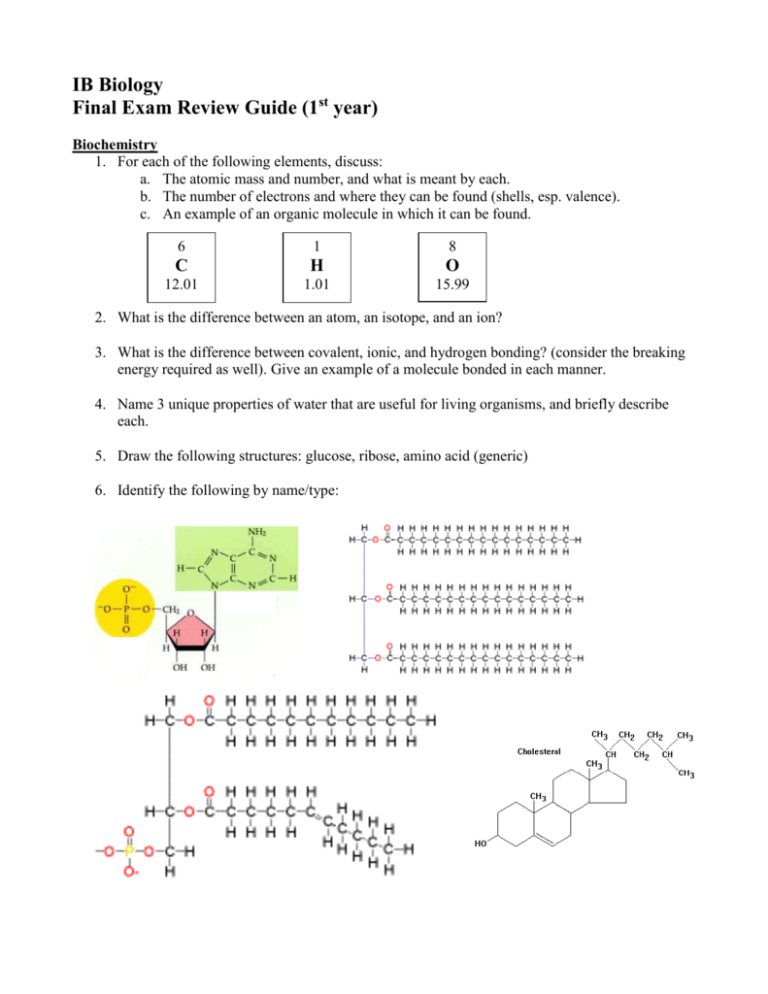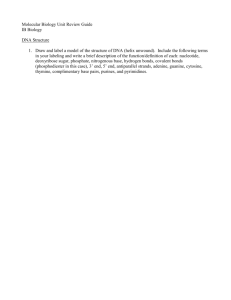IB Biology 1st year final review guide
advertisement

IB Biology Final Exam Review Guide (1st year) Biochemistry 1. For each of the following elements, discuss: a. The atomic mass and number, and what is meant by each. b. The number of electrons and where they can be found (shells, esp. valence). c. An example of an organic molecule in which it can be found. 6 1 8 C H O 12.01 1.01 15.99 2. What is the difference between an atom, an isotope, and an ion? 3. What is the difference between covalent, ionic, and hydrogen bonding? (consider the breaking energy required as well). Give an example of a molecule bonded in each manner. 4. Name 3 unique properties of water that are useful for living organisms, and briefly describe each. 5. Draw the following structures: glucose, ribose, amino acid (generic) 6. Identify the following by name/type: 7. What is an enzyme, and how does it work 8. What is enzyme activity regulated, and what are the limiting factors? 9. Identify acid, base, buffer and pH 10. What is an isomer? Give an example of one commonly used in a human diet. 11. What is a functional group? What would COOH or NH2 be considered when attached to an organic molecule? 12. Identify the differences between a monosaccharide, a disaccharide, and a polysaccharide. 13. What are the 3 primary lipid types and how are they different? 14. What are some different types of proteins (and their functions)? 15. Identify the following enzyme terms: active site, allosteric site, competitive and noncompetitive inhibitors Cellular Biology A. Cell Theory 1. Summarize the 4 points of the cell theory that was first expressed by Schleiden and Schwann. B. Cell Structures & Functions (Organelles) 2. Name the structures in the diagrams below and give the function of each structure in the provided spaces. B G I A C F D J E H Organelle Function A. _______________________ ____________________________________________________ B. _______________________ ____________________________________________________ C. _______________________ ____________________________________________________ D. _______________________ ____________________________________________________ E. _______________________ ____________________________________________________ F. _______________________ ____________________________________________________ G. _______________________ ____________________________________________________ H. _______________________ ____________________________________________________ I. _______________________ ____________________________________________________ J. ________________________ ____________________________________________________ 3. Identify 3 differences between prokaryotes and eukaryotes and label each on the right. ___________________________________________________________ ___________________________________________________________ ___________________________________________________________ 4. Identify 3 differences between plant and animal cells and label each one on the right. ___________________________________________________________ ___________________________________________________________ ___________________________________________________________ C. Membranes 5. In the diagram on the right, label which parts are the phosphates, and which parts are the lipids in the phospholipids bilayer. 6. What other parts can be found in a typical cell membrane, and what are those other parts used for? 7. Explain the difference between passive transport (diffusion) and active transport: 8. What is osmosis, and how does it work? 9. Draw a cell in a hypertonic, hypotonic, and isotonic solution (all 3), and use arrows/words to demonstrate which direction water will move through osmosis. Label the following in your drawings: solutes, solvent, cell, hypertonic solution, hypotonic solution, and isotonic solution. D. Mitosis/Meiosis 13. List the stages of mitosis in order. For each stage give a brief, 1 sentence summary of what happens in that stage. 14. Draw each of the stages of mitosis, labeling each stage and any important features that are visible (chromosomes, centrioles, spindle fibers, nuclear envelope/membrane, etc…) 15. Draw each of the stages of meiosis, labeling each stage and any important visible features (also label where crossing over takes place, homologous chromosomes, and gametes). Bioenergetics 1. 2. 3. Photosynthesis a. Light-Dependent Reactions i. Know the difference between bacterial and plant versions (cyclic and noncyclic phosphorylation, and where each takes place – be specific on chloroplasts) ii. Understand the differences between photosystems I and II, in what order they work, and how they are connected iii. Understand the role of each of the following: 1. photons of light 2. chlorophyll 3. water 4. NADP+ 5. ADP and independent P’s (Pi) 6. electrons 7. protons (H+) 8. ATP Synthase (enzyme complex) 9. proton pumps iv. Be familiar with the products of the light-dependent reactions and understand why the plant doesn’t stop there b. Light-Independent Reactions i. Understand where the energy for the Calvin Cycle comes from ii. Know how many turns produce enough product to be assembled into glucose iii. What is glucose for? Cellular Respiration a. Glycolysis i. Where does glycolysis take place? ii. Know the main function of glycolysis iii. Know how much ATP energy is used and produced b. Krebs Cycle/Citric Acid Cycle/TCA (tricarboxylic acid) Cycle i. Where does this take place? ii. Know the products of glycolysis that are used and how many iii. Know the primary products produced in the Krebs Cycle that are used in the next step c. Electron Transport Chain i. Where does this take place? ii. Understand how the products of the Krebs Cycle are used to start the ETC iii. Know the main differences between the ETC in cellular respiration and the ETC in the light-dependent reaction of photosynthesis (starting electron source, final electron receptor) iv. Understand how ATP is produced and how much net ATP is produced (overall) Energy Cycling a. Know the balanced chemical equations for photosynthesis and cellular respiration b. Understand the relationship between the two chemical equations and the processes they represent c. Be familiar with the molecules that remain in the energy cycle and which are part of connected cycles of their own Molecular Biology 1. DNA Structure a) Draw and label a model of the structure of DNA (helix unwound). Include the following terms in your labeling and write a brief description of the function/definition of each: nucleotide, deoxyribose sugar, phosphate, nitrogenous base, hydrogen bonds, covalent bonds (phosphodiester in this case), 3’ end, 5’ end, antiparallel strands, adenine, guanine, cytosine, thymine, complimentary base pairs, purines, and pyrimidines. b) What is the structure and function of a nucleosome? (use the article online) c) What is in a human’s genome, besides unique DNA codes called genes? Why? d) What are introns and exons? 2. DNA Replication e) DNA is said to be replicated semi-conservatively. What does that mean? And how is complimentary base pairing involved? f) Label the following 2 diagrams with these terms (briefly mention the function/definition of each): DNA polymerase III, RNA primase, Ligase, DNA polymerase I, replication bubble, replication fork, leading strand, lagging strand, Okazaki fragments, 5’ end, 3’ end, template strand, and new strand g) What are deoxynucleoside triphosphates, and why are they important to replication? h) How is the process of DNA replication made more efficient or faster? 3. Protein Synthesis i) Describe 3 differences between DNA and RNA. j) How does the information in a gene produce a protein (a brief synopsis)? Transcription: k) Name the 3 stages of transcription and briefly describe the details that occur during each of them: 1) 2) 3) l) Label the diagrams below with the following terms (briefly explain the function/definition of each): RNA primase, transcription factor proteins, promoter, coding region, sense strand, antisense strand, mRNA, 5’ end (of each), 3’ end (of each), nucleoside triphosphate, complimentary base pairing, and uracil. (later) m) Describe what is happening at each of the 2 points with arrows in the diagram below: 14. What modifications must the mRNA undergo after transcription, but prior to translation? Why? Translation: n) What is a protein made of? Where are proteins made (free vs. bound)? o) What is the role of tRNA in translation? And how does it come to be attached to an amino acid? p) Draw a ribosome in the space below and label the following: small ribosomal subunit, large ribosomal subunit, mRNA binding site, and tRNA binding sites (E, P, and A). What is your ribosome made of (2 parts)? q) Name the 3 stages of translation and briefly describe what takes place during each: 1) 2) 3) r) Label the diagrams below with the following terms (briefly giving the function/definition of each): small ribosomal subunit, large ribosomal subunit, amino acids, peptide bond, tRNA, mRNA, 5’ end (mRNA), 3’ end (mRNA), codons, start codon, stop codon, anti-codons, polypeptide, and release factor. (Later) s) Draw a diagram in the space below of two amino acids being connected by a peptide bond, include the important elemental symbols and structures where the bond is made and any elements or molecules that are added or subtracted from the final product. What is this reaction called? t) What is meant by the term polysome? How do these contribute to the efficiency of translation? u) What is the difference between proteins made on free ribosomes and those made on bound ribosomes? v) What must happen to a polypeptide before a complete protein is synthesized? w) How do mutations happen, name a few types, and why do they cause ineffective proteins? x) What things can affect gene expression (should have a few)? How (briefly) does each work? Genetics Use recent unit study guide for practice problems and linked genes practice. Know the following terms: 1. gene 2. allele 3. genome 4. gene mutation 5. chromosomal mutation 6. genotype 7. phenotype 8. codominant 9. locus 10. homozygous 11. heterozygous 12. carrier 13. pleiotropy 14. incomplete dominance 15. independent assortment 16. non-disjunction 17. monosomy 18. trisomy 19. sex-linked 20. karyotype 21. pedigree 22. autosomal 23. multiple alleles 24. probability 25. epistasis







